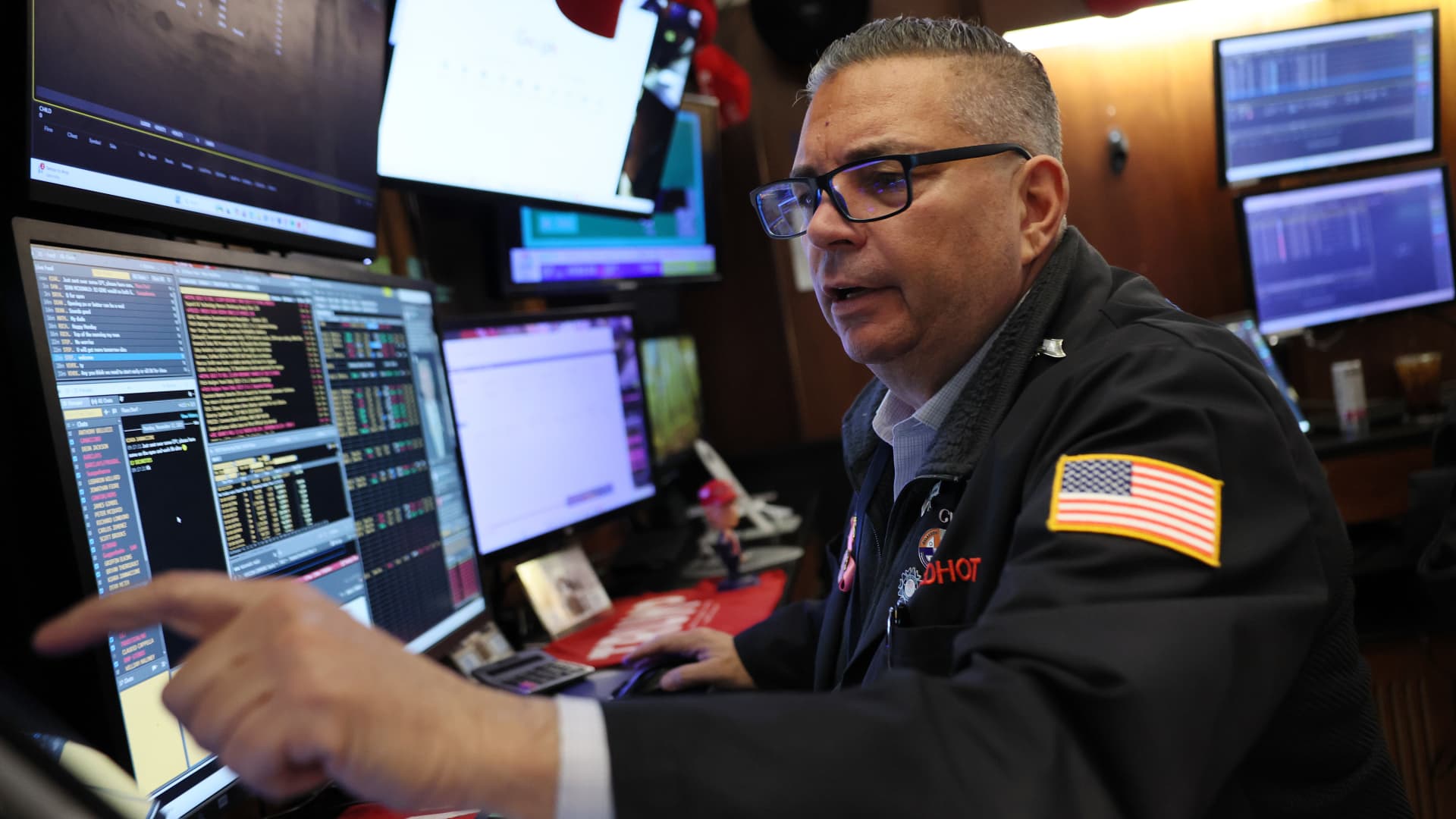Wall Street Rocked: Tech Sell-Off Triggers Market Tremors Ahead of Crucial Data
Monday delivered a stark reminder of the fragile nature of market sentiment, as major U.S. indexes recoiled sharply, casting a shadow over what had been a resilient rally. The Dow Jones Industrial Average, a barometer of the broader economy, plummeted by over 600 points, while the tech-heavy Nasdaq Composite and the S&P 500 also registered significant losses. The culprit? An all-too-familiar narrative: a broad-based decline in technology shares, spearheaded by concerns surrounding industry titan Nvidia, coupled with an overarching sense of apprehension as investors braced for a week laden with pivotal economic data and corporate earnings.
The sudden downturn wasn’t entirely unprovoked, yet its intensity caught many off guard. While the market has enjoyed periods of robust growth, particularly within the technology sector, underlying vulnerabilities have persisted. Analysts have long pointed to elevated valuations in certain high-growth tech stocks, suggesting that even minor shifts in sentiment or economic outlook could trigger significant corrections. Monday’s trading session became a vivid illustration of this theoretical risk materializing into tangible losses. The fear gauge, implied volatility, saw a noticeable uptick, signaling increased investor anxiety and a potential for further turbulence in the days to come.
Nvidia’s Gravity Well: A Bellwether’s Burden
At the epicenter of Monday’s tech sector rout was Nvidia, a company that has, for much of the past year, been an undisputed darling of Wall Street, synonymous with the artificial intelligence boom. Its chips power everything from data centers to advanced graphics, making it a critical barometer for the health and future trajectory of the AI revolution. When Nvidia shares falter, the ripple effects are felt across the entire technology ecosystem, impacting semiconductor manufacturers, cloud computing providers, and even software developers who rely on its cutting-edge hardware. The company’s recent stratospheric rise, fueled by insatiable demand for its AI accelerators, has also made it particularly susceptible to profit-taking and re-evaluation as investors scrutinize its lofty valuation multiples. The upcoming earnings report from Nvidia is not merely a quarterly financial disclosure; it is a moment of truth for the entire AI narrative, a stress test for the bullish thesis that has propelled countless tech stocks to dizzying heights.
Beyond Nvidia: Systemic Weaknesses in the Tech Ecosystem
While Nvidia captured headlines, the sell-off was far from isolated. Google parent Alphabet, despite an initial rally that briefly defied the market’s gravitational pull, found itself eventually drawn into the broader tech retreat. Other prominent tech names, from software giants to e-commerce behemoths, saw their valuations trimmed as investors engaged in a widespread reassessment of risk. This collective pullback suggests that the market’s concerns extend beyond individual company performance to systemic issues within the broader technology sector. Factors such as rising interest rates, which make future earnings less valuable and increase the cost of capital for growth-oriented companies, have consistently weighed on tech valuations. Furthermore, increasing regulatory scrutiny globally, supply chain vulnerabilities, and intensified competition in key markets continue to present headwinds that could impede sustained growth.
“The market’s reaction today isn’t just about a single company or sector; it’s a recalibration of expectations,” observed a veteran fund manager. “Investors are trying to price in a multitude of uncertainties: the trajectory of inflation, the Federal Reserve’s next moves, and the sustainability of corporate earnings in a slowing global economy. When tech, which has led the charge for so long, shows signs of weakness, the entire market takes notice.”
Anticipating the Economic Barometers: Jobs Data and Inflation’s Shadow
Compounding the tech-driven anxiety is the looming release of critical economic data later in the week, most notably the September jobs report. The state of the labor market is a paramount concern for central bankers and economists alike, as it offers crucial insights into inflationary pressures and the overall health of the economy. A stronger-than-expected jobs report, while seemingly positive, could paradoxically fuel fears that the Federal Reserve will maintain its aggressive stance on interest rate hikes for longer, further tightening financial conditions and potentially tipping the economy into recession. Conversely, a weaker report might signal economic deceleration, which could ease inflation concerns but also raise alarms about corporate earnings prospects and consumer demand. Investors are walking a tightrope, hoping for a ‘Goldilocks’ scenario – a labor market that’s cooling just enough to curb inflation without collapsing entirely.
The Broader Implications of Jobs Data and Monetary Policy
The intricate dance between employment figures and monetary policy cannot be overstated. When the Federal Reserve considers its benchmark interest rate decisions, it heavily scrutinizes data points like job creation, wage growth, and the unemployment rate. A robust job market, characterized by low unemployment and rising wages, typically implies strong consumer demand and potential inflationary pressures. To combat this, the Fed might opt for further rate increases, making borrowing more expensive for businesses and consumers, which in turn can slow economic activity and dampen corporate profits. For the stock market, particularly growth sectors like technology, higher interest rates translate to a higher discount rate for future cash flows, making their current valuations appear less attractive. This explains why investors are so acutely sensitive to employment figures; they are not just numbers, but critical signals for future monetary policy direction.
Earnings Season on the Horizon: A Litmus Test for Corporate Resilience
Beyond the September jobs report, the market is also gearing up for the broader earnings season, with Nvidia’s results serving as an early, high-stakes prelude. Corporate earnings reports provide a granular look into the financial health of individual companies and, collectively, the profitability of the economy. In a climate of rising input costs, geopolitical uncertainties, and shifting consumer behavior, the ability of companies to maintain or grow their profit margins will be under intense scrutiny. Disappointing earnings or cautious forward guidance from corporate executives could trigger further sell-offs, particularly if they indicate a widespread softening in demand or an inability to pass on higher costs to consumers. Conversely, stronger-than-anticipated results could inject a much-needed dose of optimism, potentially stabilizing the market and fostering a rebound.
Investors will be particularly keen to observe companies’ outlooks regarding their capital expenditure plans, their strategies for managing inflation, and their perspectives on consumer spending habits. Any signs of weakening demand or supply chain normalization, which might ease inflationary pressures but also signify a deceleration in economic activity, will be dissected by analysts seeking clues about the path ahead. The market, always forward-looking, will attempt to price in not just past performance but the anticipated trajectory of corporate profitability in the coming quarters.
Navigating Volatility: Investor Sentiment and Future Outlook
The current market environment is a testament to the adage that markets climb a wall of worry. Investor sentiment, currently a blend of cautious optimism and palpable anxiety, remains highly susceptible to new information. The speed and scale of Monday’s pullback underscore how quickly sentiment can shift, turning buoyant enthusiasm into defensive posture. For individual investors, such periods of volatility can be unsettling, prompting questions about portfolio allocation and risk management. Diversification across different asset classes and sectors becomes even more critical during these times, cushioning the blow from concentrated declines in specific areas like technology.
Looking ahead, the market’s trajectory in the coming weeks will largely hinge on the confluence of these factors: the true state of the labor market as revealed by the September jobs report, the Federal Reserve’s subsequent policy signals, and the ability of corporate America, particularly tech giants like Nvidia, to meet or exceed earnings expectations and provide reassuring guidance. The interplay of these forces will determine whether Monday’s market decline was merely a temporary correction, a necessary cooling-off period before renewed growth, or an ominous harbinger of a more protracted downturn. The stage is set for a tumultuous, yet incredibly informative, period for global financial markets, demanding vigilance and strategic foresight from all participants.
The resilience of the market will be tested, not just by data points, but by the underlying faith in technological innovation and economic fundamentals. As the dust settles from Monday’s sharp retreat, the focus intensifies on what comes next. Investors must navigate a landscape fraught with uncertainty, balancing the allure of potential gains against the inherent risks of a recalibrating economy. The market’s immediate future is a complex equation, where every new data point and every corporate announcement will serve as a critical variable in determining its ultimate direction. This week’s developments will undoubtedly shape the narrative for the rest of the quarter, dictating whether fear or opportunity will prevail in the minds of investors globally.
Ultimately, the market’s current state is a battleground of competing narratives: the enduring power of technological advancement versus the sobering reality of economic cycles and monetary policy tightening. The outcome of this struggle will define not just the performance of individual portfolios, but the broader economic sentiment for months to come. The era of easy money is receding, and with it, a new era of discerning investment and rigorous evaluation is dawning. Investors are being challenged to look beyond the headlines and understand the deep currents shaping global finance. This is not merely a dip; it is a fundamental stress test of the market’s underlying health and a powerful reminder that even the most dominant sectors are not immune to the forces of economic gravity and investor sentiment. The coming weeks will reveal the true strength, or fragility, of the foundations upon which today’s valuations rest.

Photo by Pexels on Pixabay.

